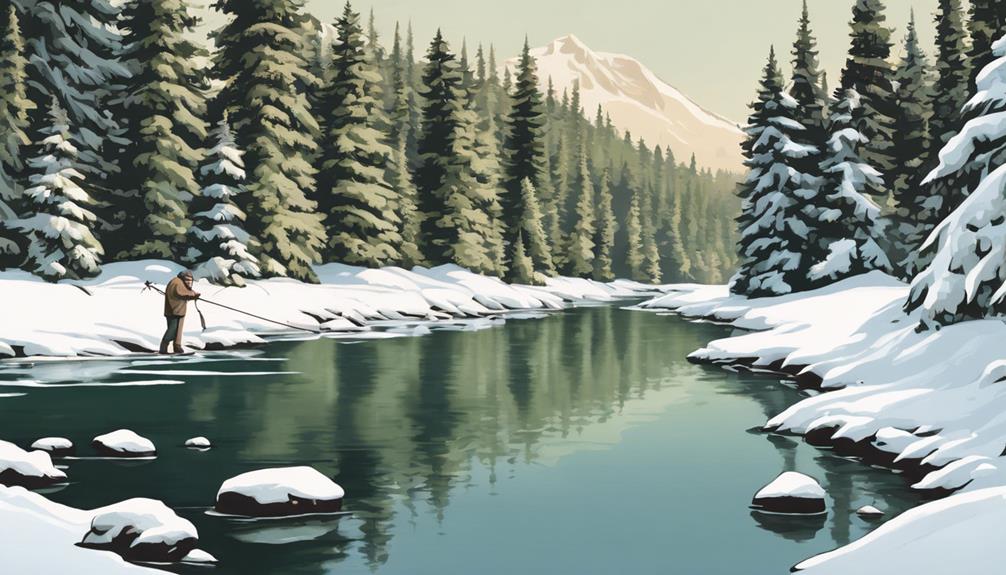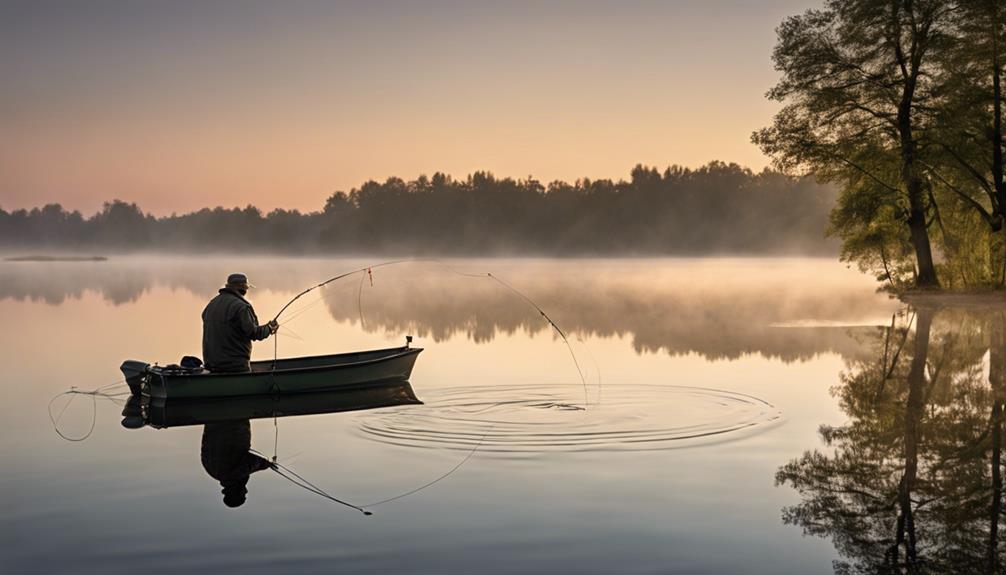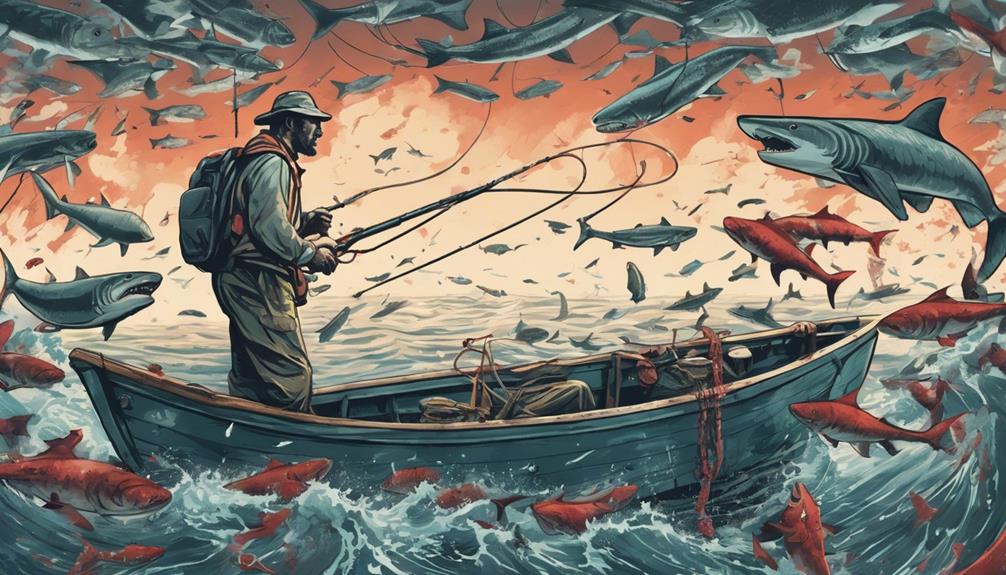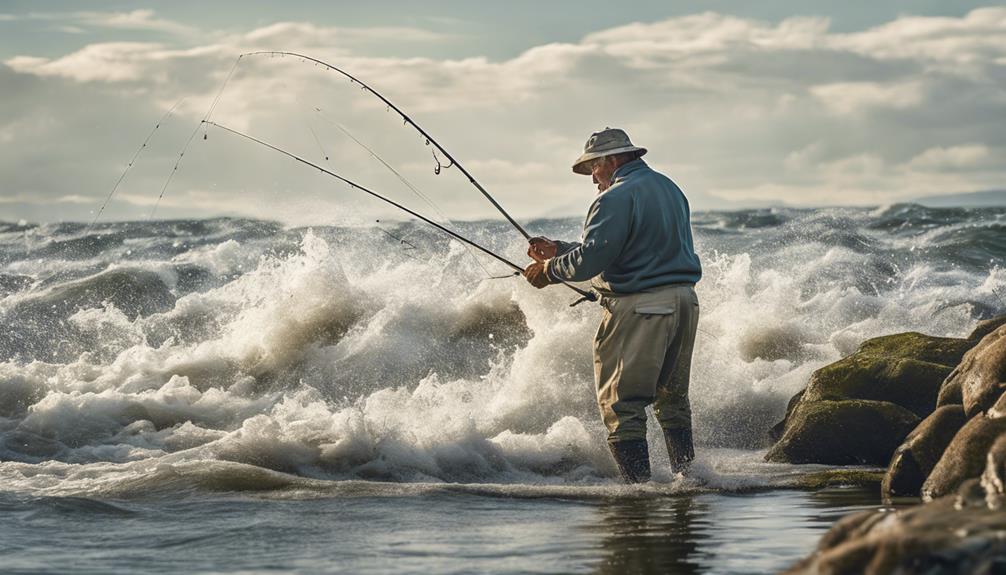Are you tired of coming home empty-handed after a day of winter trout fishing? Discover the secrets to success in the cold season with proven strategies that will elevate your angling game.
From pinpointing the best locations to understanding the behavior of elusive trout in chilly waters, this guide will equip you with the knowledge needed to reel in those prized catches.
Stay tuned to uncover expert tips and techniques that will give you the edge you need to conquer winter fishing like a pro.
Best Winter Locations for Trout
When looking for the best winter locations for trout, focus on areas with slower-moving water and deeper pools. Trout tend to seek refuge in these spots during colder months, where the water is more stable and provides protection from harsh winter conditions. High altitude streams, especially those that are spring-fed, are excellent choices as they maintain a relatively constant temperature, keeping the trout active and feeding.
In winter, trout are less likely to chase after fast-moving prey. Instead, they look for easy meals that require less energy to catch. This is where winter streamers come into play. These bait options mimic small fish or insects, enticing trout to strike. When fishing in high altitude, spring-fed streams, consider using winter streamers to attract trout lurking in the deeper pools.
Additionally, topwater baits can be effective in winter, especially during milder days when trout may be more active near the surface. These baits create surface disturbance, resembling insects or small creatures falling into the water, which can trigger a feeding response from trout. When targeting trout in winter, don't overlook the potential of topwater baits to entice strikes from these cold-water fish. Remember, adapting your bait choices to the winter conditions and the behavior of trout can significantly improve your chances of a successful fishing trip.
Effective Bait Options for Winter
Consider utilizing a variety of bait options tailored to winter conditions to maximize your chances of enticing trout bites. In winter, trout are more lethargic, making it crucial to adapt your bait choices accordingly. Artificial lures can be effective, especially those that mimic small fish or insects. Slowly retrieving these lures can entice strikes from trout that are less willing to chase prey. Natural baits such as worms, minnows, or even pieces of salmon eggs can also be successful during the colder months. These baits offer a realistic scent and appearance that can attract trout in various water conditions.
When using artificial lures, opt for smaller sizes as trout tend to be less aggressive in winter. Additionally, consider lures that have a subtle action in the water to mimic the slower movements of natural prey during this season. On the other hand, when using natural baits, present them slowly to the fish. Allow the bait to drift naturally in the water or use gentle twitches to give the illusion of a struggling creature. This slow presentation can often lead to quick bites from trout that are conserving energy in the cold water.
Optimal Gear Selection for Cold
What gear should you prioritize for cold weather trout fishing to enhance your chances of success?
When gearing up for cold weather trout fishing, proper clothing and gear maintenance are crucial for a comfortable and successful fishing experience.
Firstly, ensure you have appropriate clothing to keep you warm and dry. Opt for thermal layers, waterproof outerwear, insulated gloves, and a warm hat to protect yourself from the cold. Insulated waterproof boots are also essential to keep your feet warm and dry throughout the day.
In addition to clothing, gear maintenance is key in cold weather conditions. Make sure your fishing rods and reels are well lubricated to prevent freezing. Cold weather can cause lines to become stiff, so it's essential to regularly check and replace your fishing line to avoid any issues while fishing. Keep your tackle box organized and free of any rust by wiping down your lures and hooks after each use.
When selecting gear for cold weather trout fishing, consider investing in a quality ice fishing shelter or tent to shield yourself from harsh winds. A portable heater can also be beneficial to keep you warm during long hours on the ice.
Key Techniques for Ice Fishing
To maximize your success in ice fishing, mastering key techniques is essential. When venturing onto the frozen waters, understanding shelter options and the process of hole drilling are crucial. Portable ice shelters provide protection from the harsh elements, allowing you to fish comfortably for extended periods. When drilling holes, ensure the ice thickness is safe – a minimum of four inches is generally recommended for walking on, while eight to twelve inches is preferable for supporting a vehicle.
In ice fishing, knowing fish movement patterns is fundamental. Fish tend to be more lethargic in the cold water, so positioning your bait at the right depth is vital. Start by targeting shallower areas in the early morning and late afternoon when fish are more active near the surface. As the day progresses, they may move to deeper waters, so adjust your bait accordingly.
It's also essential to stay mobile and drill multiple holes to locate fish. Once you've identified a promising spot, try different bait presentations and jigging techniques to entice the fish. By adapting to the fish's behavior and being patient, you'll increase your chances of a successful ice fishing expedition.
Mastering Winter Fly Fishing
Mastering Winter Fly Fishing requires adapting your techniques to the colder conditions while understanding the behavior of trout in these environments. During winter, stream temperature drops, affecting trout activity. To optimize your chances of a successful catch, it's crucial to focus on areas where the water temperature is more stable, such as deep pools or slow-moving sections. Trout tend to conserve energy in colder temperatures, so they may not move far to feed. Therefore, presenting your fly precisely is key.
When it comes to fly selection, opt for patterns that imitate the natural food sources available to trout in winter. Consider using midge patterns, small nymphs, or even streamers to entice trout in these challenging conditions. Since trout may be less willing to chase down prey in the cold, choosing flies that can be presented at varying depths and speeds is essential.
Remember that trout have a slower metabolism in winter, so they may not aggressively strike at your fly. Be patient and adjust your presentation to tempt them. By being mindful of stream temperature and selecting the right flies, you can enhance your winter fly fishing experience and increase your chances of landing that prized trout.
Tips for Navigating Frozen Waters
Adapting your fishing approach to frozen waters requires a different set of skills and strategies to maximize your chances of success. When venturing onto frozen lakes for trout fishing, mastering ice fishing techniques is crucial. Start by drilling a hole in the ice using an auger, ensuring it's of adequate size for your gear. An ice chisel can also be handy for cutting through thicker ice.
Winter gear essentials are vital for a successful frozen water fishing expedition. Dress warmly in layers, including waterproof clothing, insulated boots, and gloves to shield yourself from the cold. Additionally, ice picks worn around your neck can be life-saving in case of an accidental fall through the ice. A sled to transport your gear across the ice, along with a portable shelter like an ice tent, can provide much-needed respite from the biting winds.
When setting up your fishing spot, consider using a sonar fish finder to locate potential trout beneath the ice. Small jigs, spoons, or baited hooks can attract trout in these frigid conditions. Keep your movements slow and subtle to avoid spooking the fish. By employing these ice fishing techniques and ensuring you have the right winter gear essentials, you'll be well-equipped to navigate frozen waters and increase your chances of landing that prized winter trout.
Understanding Trout Behavior in Winter

Explore how trout behavior shifts during the winter months to enhance your chances of a successful fishing expedition. In winter, trout behavior is influenced by a combination of factors, including winter feeding habits and temperature changes. Understanding how these factors affect trout can help you tailor your fishing approach for the season.
- Winter Feeding: During the colder months, trout tend to be less active and conserve energy. This means they're more selective about when and what they feed on. They may feed less frequently but can still be enticed by the right bait presented in a precise manner.
- Temperature Changes: As the water temperature drops, trout metabolism slows down, leading to a decrease in activity levels. Trout often seek out areas with stable temperatures, such as deep pools or slow-moving sections of rivers, where they can conserve energy and remain relatively undisturbed.
- Adaptation Strategies: To maximize your chances of catching trout in winter, consider using slower retrieval speeds, downsizing your bait, and focusing on presenting your bait at the right depth. Patience is key during this season, as trout may take longer to decide on striking your bait.
Safety Precautions for Cold Weather
When venturing out for winter trout fishing, it's crucial to prioritize safety precautions for cold weather to ensure an enjoyable and secure fishing experience. One of the most important safety measures is proper layering of clothing. Dressing in layers helps retain body heat and provides flexibility to adjust to changing weather conditions. Start with a moisture-wicking base layer to keep sweat away from your body, add an insulating layer like fleece or down for warmth, and finish with a waterproof and wind-resistant outer layer to protect against the elements.
In cold weather, it's easy to forget about staying hydrated, but it's just as important in winter as it's in summer. Dehydration can sneak up on you in low temperatures as your body works harder to stay warm. Be sure to drink plenty of fluids before, during, and after your fishing trip. Consider using an insulated water bottle to prevent your water from freezing.
Additionally, don't overlook the significance of protecting your extremities. Wearing insulated gloves, thick socks, and a warm hat can help prevent frostbite and keep you comfortable throughout the day. Remember to pack extra pairs of gloves and socks in case they get wet. By following these safety precautions and being prepared for the cold weather, you can have a successful and safe winter trout fishing adventure.
Frequently Asked Questions
How Can I Prevent My Fishing Line From Freezing in Cold Winter Temperatures?
To prevent your fishing line from freezing in cold winter temperatures, consider using a line conditioner before heading out. This will help keep your line flexible and less prone to freezing.
Additionally, try to keep your line moving by reeling it in periodically to prevent ice buildup.
Are There Any Specific Regulations or Restrictions for Winter Trout Fishing That I Should Be Aware Of?
When winter trout fishing, it's crucial to be aware of specific regulations and restrictions. Always check local fishing guidelines for any rules on catch limits, fishing methods, or designated areas.
Make sure your winter clothing and gear meet all requirements, and don't forget safety precautions. Stay updated on any changes in regulations that might affect your fishing trip.
Being informed will help you have a successful and enjoyable winter fishing experience.
What Are Some Common Mistakes That Anglers Make When Fishing for Trout in the Winter?
When fishing for trout in the winter, some common mistakes anglers make include not using proper gear and incorrect fishing techniques.
It's crucial to have the right equipment tailored for colder conditions and to adjust your fishing style to match the behavior of trout during the winter months.
How Can I Determine the Thickness of Ice on a Frozen Lake or River Before Venturing Out to Fish?
Before heading out to fish on a frozen lake or river, it's crucial to prioritize ice safety. To determine ice thickness, use an auger or ice chisel to drill test holes at different spots. Check the ice's color and clarity, as clear blue ice is the strongest.
Always wear essential winter gear like ice picks, a life jacket, and warm clothing. Take precautions, stay alert, and never assume the ice is safe based on appearance alone.
Are There Any Unique Challenges or Obstacles That Anglers May Face When Fishing for Trout in the Winter Compared to Other Seasons?
When fishing for trout in winter, you face unique challenges. Winter trout behavior changes as they seek warmer water and feed less.
Ice fishing techniques become crucial, requiring specialized gear and knowledge. Stay safe by checking ice thickness before venturing out.
Be prepared for colder temperatures and less predictable fish behavior. Adapt your strategy to the season, and you'll increase your chances of a successful winter trout fishing adventure.
Conclusion
Now that you have uncovered the winning winter trout fishing strategies, it's time to hit the frozen waters with confidence. Remember to target the best locations, use effective bait options, select the right gear, and master key techniques for success.
Whether you're ice fishing or fly fishing, understanding trout behavior in winter is crucial. Stay safe in the cold weather, and enjoy a successful winter fishing season!



